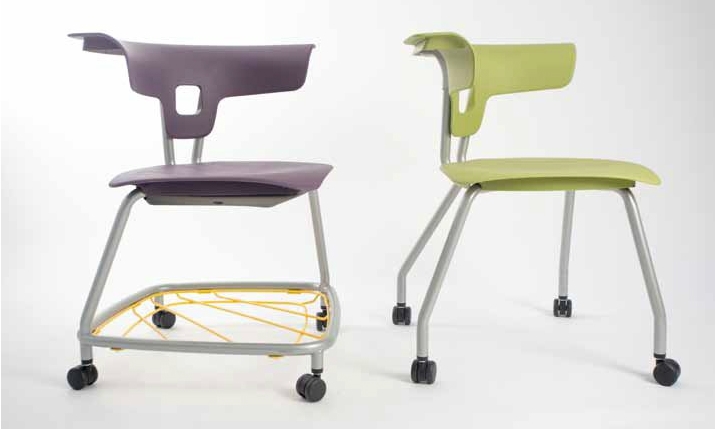Campus Estate Management visited the London offices of KI to learn about latest developments from this furniture manufacturer. The company showed us new products that address how students really learn and how innovative educators want to teach.
Latest offerings that are helping KI to achieve these goals include Ruckus, a school chair that is taking ergonomics to a new level with a versatility that acknowledges how the same teaching material in the same classroom may result in different styles of learning. Collaborative instruction that is truly student-centred may involve much movement in the chair around classrooms which no longer have rigid seating configurations.
KI’s in-house product development team worked with posture specialists, interior designers, architects, facility administrators and educators to create chairs like Ruckus which have the versatility to support various usage according to how individual students are engaging with the teaching material and their peers.
New designs acknowledge that teaching is now often project-based; chairs must allow effective use of tablet devices and interactive smartboards as well as traditional materials. KI’s marketing staff showed Campus how students no longer expect to have to move their chairs but want to move within the chair so that they can constantly redirect their attention in a dynamic learning environment.
Numerous studies have shown that freedom of movement improves involvement with the materials, the learning tools, teachers and classmates. Students achieve the best concentration and retention levels if they are physically relaxed and can move the chair as they wish. Teaching that emphasises movement, with increasing use of break-out spaces as opposed to classrooms, mean that chairs with a castor base are becoming increasingly popular. This trend will increase as teachers focus on participatory lessons with peer discussion rather than talking at length to assembled groups who are sitting in a conventional configuration. Ruckus shows KI responding to and even anticipating this evolution.
Moving within the chair
The variety of positions in the photographs here shows that the choice is no longer just to move the chair but students can move within the chair to suit their own style of engagement and can even perch on it if they are working at a standing-height table. For the more traditional posture styles, Ruckus features a curved backrest and integrated arm rests. It also has a waterfall seat edge which offers support and comfort while encouraging correct spine posture.
Ruckus is available as a task chair (designed to be used with a desk or table), a four-leg chair and a stacking chair with an optional storage rack in the base that allows students to stow away bags. The seat and backrests are made of polypropylene with seven percent fibreglass reinforcement.
There are 24 standard polypropylene colours available for the seat and backrest. The frame is available in chrome or numerous powder-coat paint finishes. Glides and castors can be specified according to floor type. An upholstered seat pad is available if required. Crucially, Ruckus promotes mobility in terms of student learning styles and yet it has no moving parts.
This innovative multi-use and game-changing chair was created at KI’s R&D laboratory where the company works to best practice recommendations from the Business and Institutional Furniture Manufacturers Association (BIFMA). KI liaises with trade bodies to find optimum means of design and manufacture in terms of technological advances, safety, ergonomics and minimising carbon footprint.
As with all their products, KI developed Ruckus by observing how students and teachers used prototype versions of the chair. This is a ground-up empathetic process that assesses the preferences and behaviour of future end-users. Many hours were spent analysing postures, preferred learning styles, patterns of concentration and engagement.
KI is dedicated to creating optimised products that are pragmatic in balancing how architects design a space with the likely approaches in real-life teaching environments. A notable aspect of Ruckus is that it is almost impossible to lean back in it excessively – a feature that results from extensive field testing.
KI’s products offer lengthy warranties making KI an industry byword for strength of materials and products. And yet aesthetic concerns are also to the fore; on the day that Campus editorial staff visited KI’s City of London Office the management team was about to welcome a group of architects and art lecturers for a session that would include a drawing class – that utilises the Ruckus chair, of course!
Founded in 1941, KI (Krueger International, Inc.), has grown to become one of the world's largest and most respected independent furniture manufacturing groups. KI’s EMEA headquarters and showroom in Central London is supported by an established network of manufacturing facilities and distribution partners across the UK, Europe and the Middle East.
